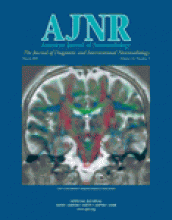Duane E. Haines, Ed. Churchill Livingstone. 2001. 582 pages.
“Back to the Basics” could be the subtitle of this well-written, abundantly illustrated, and useful text on fundamental concepts that are routinely encountered in neuroradiology. Many features are beneficial to the potential reader. With this review, I attempt to summarize why Fundamental Neuroscience should be available in every departmental library, particularly in those departments that offer a neuroradiology fellowship program. Additionally, the book offers such a diverse review that many in our field should consider purchasing copies for their personal libraries.
Twenty-five authors have contributed their expertise in three major sections: Essential Concepts, Regional Neurobiology, and Systems Neurobiology. The first section, Essential Concepts, deals with the basic structure of the CNS. Interestingly, the authors introduce neuroimaging in this section (which is useful for the general clinician). Thereafter, succinct descriptions of the biology of neurons and glia, electrochemistry of the CNS, chemical neurotransmission, and development of the brain, spinal cord, and peripheral nervous system are presented. What makes these chapters (89 pages in all) valuable is that the authors emphasize the highlights of each area, thus preventing the reader from getting bogged down with excessive information.
The second section, Regional Neurobiology (142 pages), reviews the structural and functional anatomy of the CNS and includes chapters that are devoted to the brain stem, cerebellum, cerebrum, spinal cord, vascular supply to the brain, meninges, and ventricular system. These chapters, although well written and well illustrated, will be of least value to the experienced neuroradiologist who is already familiar with the specific anatomic points.
The third section, Systems Neurobiology (286 pages), deals with subjects that will be of greatest interest to neuroradiologists—both trainees and those in active clinical practice. Each of the critical areas of neurologic function is clearly reviewed in separate chapters: the somatosensory system (touch, position, pain, temperature), the viscerosensory pathway, the visual system (sensory and motor), the auditory and vestibular system, olfaction and taste, the motor system, basal nuclei, cerebellar function, the visceral motor pathway, the hypothalamus, the limbic system, the cerebral cortex, and the essentials of neurologic examinations. This last brief chapter (15 pages) does seem a bit out of place. Perhaps the information concerning neurologic examinations would have been better presented if integrated into the appropriate chapters.
What is highly commendable, and what in part distinguishes this book from other similar texts, is that the editor of this book (Dr. Haines) was able to limit each chapter to the essential and important points, resulting in chapter after chapter in similar format and of generally similar length. Such a presentation encourages the reader to be interested in completing one chapter and going on to the next. As opposed to most textbooks of this genre, Functional Neuroscience is one that can be read cover to cover without getting bogged down in material that might not be immediately transferable to the daily practice of neuroradiology.
Much of the material that neuroradiologists deal with on a daily basis can be related to information learned (and, in many instances, subsequently forgotten) in medical school. Do not expect to see material on the more advanced topics in the neurosciences, such as transduction, neural growth factors, genomics, transplantation, and the like. After all, it is not the book’s intent to present such topics. The inclusion of historical backgrounds of many areas makes for interesting reading and allows the information to be retained. The derivation and origins of terms we use daily are explained. The book continually integrates clinical syndromes and types of CNS dysfunction into each chapter and correlates these with anatomic connections and neurophysiological factors. I think the greatest attribute of the book is the excellent combination of line drawings, summary tables, patient photographs, gross anatomic images, and microscopic anatomy. At many levels, the authors bring into play the clinical counterparts of the systems and functional neurobiology they are describing. I highly recommend this compact book to the readers of the AJNR.
- Copyright © American Society of Neuroradiology












